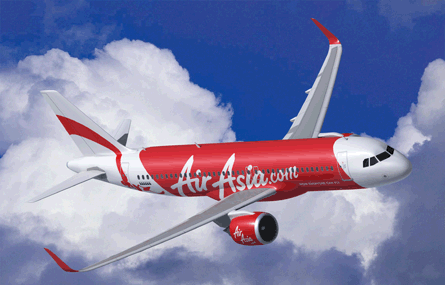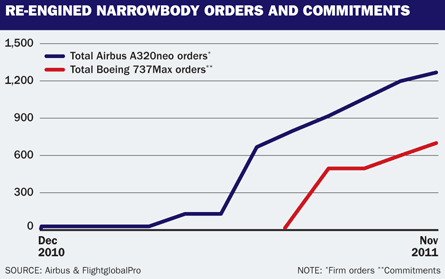When Boeing bowed to the inevitable in July and abandoned plans for its New Single Aisle aircraft and instead opted to offer a re-engined version of its 737, there was always some doubt as to how the market would shape up.
Thanks in part to a successful Paris air show, by the time Boeing officially launched its 737 Max in August, Airbus had racked up 918 firm orders for its re-engined A320neo family.
And although Boeing's first identified customer for the CFM International Leap-1B-powered narrowbody was American Airlines with a substantial order for 100 of the type in July, at the same time the carrier ordered 130 A321neos, marking the defection of a previously loyal Boeing customer.
But since then Boeing's numbers have steadily risen, with the Seattle airframer noting at the Dubai air show earlier this month that it was now around the 700-orders mark. Two more customers - albeit that all orders for the 737 Max are conditional on validation of its performance - have since come to light in the shape of Indonesian carrier Lion Air, with a commitment for 201 of the type, and US lessor Aviation Capital Group which provisionally agreed to take 35 aircraft.
Meanwhile, Airbus has continued to pile on orders for the Neo, taking its firm total to 1,268 aircraft from 21 customers since its launch in December 2010. Notwithstanding the artificial boost caused by the spending frenzy at Le Bourget, the two rivals' orders are tracking at a broadly similar rate.
 |
|---|
© Airbus |
There is a sense, then, that it is very much business as usual in the narrowbody segment. "With Boeing deciding to re-engine, you could almost argue it maintains the status quo with the big two - both will have airframes which are known quantities, combined with the latest generation of engines," said Chris Seymour, head of market analysis at Flightglobal's Ascend consultancy division. "Yes, each will argue that their design is better than the other's, but neither has a 'step-change' difference that you would have seen if one had pursued an all-new design."
It's a view shared by Teal Group vice-president, analysis, Richard Aboulafia. He said: "I don't believe there are any obstacles to the continued 50/50 split of the market. It's a story about engines, not airframes anyway. The only thing that could change the situation is if the [Pratt & Whitney] GTF is significantly better than the [CFM] Leap-X."

Thanks to offering a choice of engines on the Neo - CFM's Leap-1A and the Pratt & Whitney PW1100G - Airbus is arguably better hedged in the event that one engine manufacturer achieves significantly better performance than the other.
"These are two very different approaches to engine design," said Aboulafia. "Either you have two very different designs that lead to the same result or someone has got a winner and the other guy may have to rethink - we just don't know. Pratt has a pretty compelling argument but you wouldn't bet against GE either."
But Seymour notes that the lack of an engine choice has not harmed sales of the 737NG. He said: "If the PW1100G turns out to be significantly better than the Leap-X, then that may be a positive for the Neo; however given the general short-haul nature of narrowbody operations, it is debatable how much advantage lower fuel burn really is in the overall cost equation."
Having no engine choice, he noted, is, however, positive from a values or remarketing perspective.
 |
|---|
© Boeing |
The other unanswered question is whether either airframer can make inroads into the other's customer base. Aside from the order from American, Airbus has had minor success so far with orders from Boeing operators SAS and Garuda - albeit that the aircraft are destined for parts of the carriers whose allegiance to Boeing has never been unswerving - but there is yet to be a major defection. There would need to be an utterly compelling financial reason for a stalwart 737 operator to switch to a GTF-powered A320neo because the costs to change fleets are so high. With the 737 Max yet to be fully defined, existing 737 customers are clearly waiting to see just how much commonality there is with the current airframe.
And while the focus is very much on orders for the re-engined models, Boeing and Airbus continue to increase the backlogs for their current generation narrowbodies, standing at 2,157 and 2,153 aircraft respectively, according to Flightglobal ACAS data.
Source: Air Transport Intelligence news



















